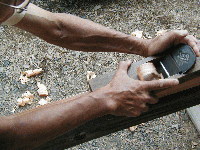
A forge is a type of hearth used for heating metals, or the workplace (smithy) where such a hearth is located. The forge is used by the smith to heat a piece of metal to a temperature where it becomes easier to shape by forging, or to the point where work hardening no longer occurs. The metal is transported to and from the forge using tongs, which are also used to hold the workpiece on the smithy's anvil while the smith works it with a hammer. Sometimes, such as when hardening steel or cooling the work so that it may be handled with bare hands, the workpiece is transported to the slack tub, which rapidly cools the workpiece in a large body of water. However, depending on the metal type, it may require an oil quench or a salt brine instead; many metals require more than plain water hardening. The slack tub also provides water to control the fire in the forge.
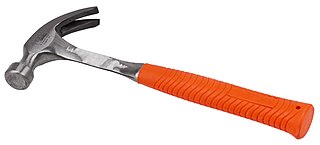
A modern day hammer is a tool consisting of a weighted "head" fixed to a long handle that is swung to deliver an impact to a small area of an object. This can be, for example, to drive nails into wood, to shape metal, or to crush rock. Hammers are used for a wide range of driving, shaping, and breaking applications.

A chisel is a tool with a characteristically shaped cutting edge of blade on its end, for carving or cutting a hard material such as wood, stone, or metal by hand, struck with a mallet, or mechanical power. The handle and blade of some types of chisel are made of metal or of wood with a sharp edge in it.

A ferrule is any of a number of types of objects, generally used for fastening, joining, sealing or reinforcement. They are often narrow circular rings made from metal, or less commonly, plastic. Ferrules are also often referred to as eyelets or grommets within the manufacturing industry.

A hand plane is a tool for shaping wood using muscle power to force the cutting blade over the wood surface. Some rotary power planers are motorized power tools used for the same types of larger tasks, but are unsuitable for fine scale planing where a miniature hand plane is used.

A spokeshave is a tool used to shape and smooth woods in woodworking jobs such as making wheel cart wheel spokes, chair legs, paddles, bows, and arrows. Historically, a spokeshave was made with a wooden body and metal cutting blade. With industrialization metal bodies displaced wood in mass-produced tools.
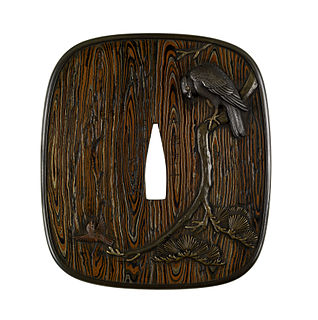
Mokume-gane is a Japanese metalworking procedure which produces a mixed-metal laminate with distinctive layered patterns, as well as that laminate itself. Mokume gane translates closely to "wood grain metal" or "wood eye metal" and describes the way metal takes on the appearance of natural wood grain. Mokume gane fuses several layers of differently coloured precious metals together to form a sandwich of alloys called a "billet." The billet is then manipulated in such a way that a pattern resembling wood grain emerges over its surface. Numerous ways of working the mokume gane create diverse pattens. Once the metal has been rolled into a sheet or bar, several techniques are used to produce a range of effects.

A mallet is a kind of hammer, often made of rubber or sometimes wood, that is smaller than a maul or beetle, and usually has a relatively large head. The term is descriptive of the overall size and proportions of the tool, and not the materials it may be made of, though most mallets have striking faces that are softer than steel.

Juggling clubs are a prop used by jugglers. Juggling clubs are often simply called clubs by jugglers and sometimes are referred to as pins or batons by non-jugglers. Clubs are one of the three most popular props used by jugglers; the others being balls and rings.

A pickaxe, pick-axe, or pick is a hand tool with a hard head attached perpendicular to the handle.

Japanese carpentry is carpentry in Japan.
A priest, sometimes called a fish bat, is a tool for killing game or fish.

Ribbon is a component of rhythmic gymnastics composed of a handle, a ribbon and attachment.
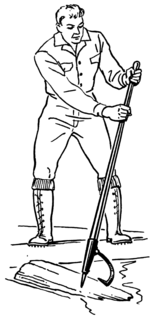
A cant hook or cant dog is a traditional logging tool consisting of a wooden lever handle with a movable metal hook called a dog at one end, used for handling and turning logs and cants, especially in sawmills. A peavey or peavey hook is similar, but has a spike in the end of the handle, whereas a cant dog has a blunt end or possibly small teeth for friction.

A fire iron is any metal instrument for tending a fire.
A shobo is a weapon, similar to the Emeici of China, which was used by the ninja of Japan for striking pressure points on an opponent. It was a piece of wood that was gripped by the wielder and was hung by a ring worn on the middle finger. Some versions were rings with a wooden peg attached on top. The ends were exposed and were usually sharp, which made them effective for paralyzing and even killing enemies quickly and without leaving a trace. They were easily hidden in the fists and were very lightweight and portable. They were usually worn in pairs. Many ninjas constructed their own shobo, although some were given from master to student.
Fly rod building is the art of constructing a fly fishing rod to match the performance desires of the individual angler.
This glossary of woodworking lists a number of specialized terms and concepts used in woodworking, carpentry, and related disciplines.
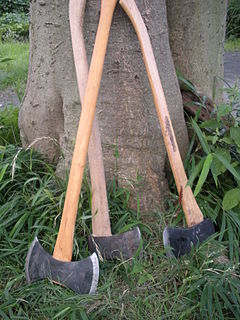
An axe is an implement that has been used for millennia to shape, split and cut wood, to harvest timber, as a weapon, and as a ceremonial or heraldic symbol. The axe has many forms and specialised uses but generally consists of an axe head with a handle, or helve.

